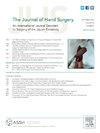Determining the Optimal Intramedullary Screw Canal Fill Ratio in Length Unstable Metacarpal Fractures: A Biomechanical Investigation
IF 2.1
2区 医学
Q2 ORTHOPEDICS
引用次数: 0
Abstract
Purpose
Intramedullary (IM) screw fixation is gaining popularity in the treatment of metacarpal fractures. Despite its rapid adoption, there is a paucity of evidence regarding parameters to optimize effectiveness. This study aimed to quantify the relationship between stability, IM screw size, and canal fill using a cadaveric model.
Methods
Thirty cadaveric metacarpals (14 index, 13 middle, and three ring fingers; mean age: 58.3 years, range: 48–70) were selected to allow for canal fill ratios of 0.7–1.1 for screws sized 3.0, 3.5, and 4.5 mm. Metacarpals underwent a 45° volar–dorsal osteotomy at the midpoint before fixation with an IM screw. Specimens were subjected to 100 cycles of loading at 10 N, 20 N, and 30 N before load-to-failure testing. Correlation coefficients for angular displacement on the final cycle at each load, peak load to failure, and average stiffness were assessed.
Results
Correlation coefficients for the angular displacement on the 100th cycle were as follows: 10 N, R = 0.62, 20 N, R = 0.57, and 30N, R = 0.58. Correlation values for peak load to failure as a function of canal fit were as follows: 3.0 mm, R = 0.5, 3.5 mm, R = 0.17, and 4.5 mm, R = 0.44. The canal fill ratio that intersected the line-of-best fit at an angular deformity of 10° was 0.74. Average peak forces for 3.0-, 3.5-, and 4.5-mm screws were 79.5, 136.5, and 179.6 N, respectively. Average stiffness for each caliber was 14.8, 33.4, and 52.3 N/mm.
Conclusions
Increasing screw diameter and IM fill resulted in more stable fixation, but marginal gains were seen in ratios >0.9. A minimum fill ratio of 0.74 was sufficient to withstand forces of early active motion with angular deformity <10°.
Clinical relevance
An understanding of the relationship of IM fill ratio of metacarpal screws to fracture stability may provide a framework for clinicians to optimally size these implants.
确定长度不稳定掌骨骨折的最佳髓内螺钉髓腔填充率:生物力学研究
目的:髓内(IM)螺钉固定在治疗掌骨骨折方面越来越受欢迎。尽管它被迅速采用,但有关优化疗效参数的证据却很少。本研究旨在使用尸体模型量化稳定性、IM螺钉尺寸和髓管填充之间的关系:方法:选取 30 个尸体掌骨(14 个食指、13 个中指和 3 个无名指;平均年龄:58.3 岁,范围:48-70 岁),以便对其进行解剖:选择的螺钉尺寸为 3.0、3.5 和 4.5 毫米,可实现 0.7-1.1 的椎管填充率。在用 IM 螺钉固定之前,掌骨在中点进行了 45° 背侧截骨。在进行加载至破坏测试之前,试样分别在 10 N、20 N 和 30 N 下承受了 100 个循环的加载。评估了每个载荷下最后一个循环的角位移、破坏时的峰值载荷和平均刚度的相关系数:第 100 个周期的角位移相关系数如下:10 N,R = 0.62;20 N,R = 0.57;30 N,R = 0.58。失效峰值载荷与管道契合度的相关值如下:3.0 毫米,R = 0.5;3.5 毫米,R = 0.17;4.5 毫米,R = 0.44。在角度变形为 10° 时,与最佳拟合线相交的牙槽骨充填率为 0.74。3.0 毫米、3.5 毫米和 4.5 毫米螺钉的平均峰值力分别为 79.5 牛、136.5 牛和 179.6 牛。每种口径的平均硬度分别为 14.8、33.4 和 52.3 N/mm:结论:增加螺钉直径和 IM 填充量可获得更稳定的固定效果,但当比率大于 0.9 时,效果甚微。最小填充率为 0.74,足以承受早期主动运动的力量和角度畸形:了解掌骨螺钉的IM填充比与骨折稳定性之间的关系可为临床医生提供一个框架,以优化这些植入物的尺寸。
本文章由计算机程序翻译,如有差异,请以英文原文为准。
求助全文
约1分钟内获得全文
求助全文
来源期刊
CiteScore
3.20
自引率
10.50%
发文量
402
审稿时长
12 weeks
期刊介绍:
The Journal of Hand Surgery publishes original, peer-reviewed articles related to the pathophysiology, diagnosis, and treatment of diseases and conditions of the upper extremity; these include both clinical and basic science studies, along with case reports. Special features include Review Articles (including Current Concepts and The Hand Surgery Landscape), Reviews of Books and Media, and Letters to the Editor.

 求助内容:
求助内容: 应助结果提醒方式:
应助结果提醒方式:


